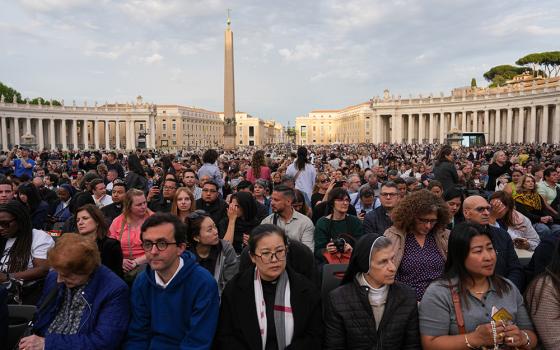Solar panels cover the roof of the Vatican's Paul VI audience hall in this photo released by the Vatican in 2008. The hall's original concrete roof was replaced with panels of photo-electric cells, generating the city's first solar power. (CNS/Vatican)
Pope Francis appointed two special commissioners to start work on building an agrivoltaic system on a Vatican property outside of Rome that could supply the whole of Vatican City's energy needs.
"There is a need to make a transition to a model of sustainable development that reduces greenhouse gas emissions into the atmosphere, establishing the goal of climate neutrality," he said in an apostolic letter issued "motu proprio," on his own initiative.
The letter, titled "Brother Sun," was dated June 21, the summer solstice and the longest day of the year. The Vatican published the letter June 26.
"Humanity has the technological means needed to tackle this environmental transformation and its pernicious ethical, social, economic and political consequences, and among these, solar energy plays a key role," he wrote.
The pope called for the building of an agrivoltaic plant on Vatican property about 11 miles outside of Rome in the area of Santa Maria di Galeria where an array of short wave directional antennas of Vatican Radio are located.
Agrivoltaic systems are a series of solar panels that coexist with crops, livestock or both, such as by having panel arrays on top of greenhouses, interleaved among fields or elevated above them so they can still be used for agricultural purposes.
Advertisement
The future installation will be projected to "ensure, not only the power supply of the radio station existing there, but also the complete energy support of Vatican City State," he wrote.
The pope appointed two special commissioners to spearhead the project: the president of the commission governing Vatican City State, Cardinal Fernando Vérgez Alzaga, and the president of the Administration of the Patrimony of the Holy See (APSA), Archbishop Giordano Piccinotti. APSA directly administers Vatican real estate and properties.
He appointed the two presidents to be "extraordinary commissioners with the full capacity to carry out the necessary acts of ordinary and extraordinary administration," and he ordered the Vatican Secretariat of State to facilitate the commissioners' "every request and work to ensure that nothing is lost in that territory, which has been available to the Holy See" after it was ceded by Italy in an accord in 1951.
The Vatican has been seeking to drastically reduce its environmental impact by adopting more renewable energy sources, pursuing a goal of zero emissions by 2050 and assembling a net-zero-emissions fleet of vehicles by 2030.
In 2022, the Vatican joined the 1992 United Nations Framework Convention on Climate Change and the 2015 Paris Agreement.
The pope said that by having the Vatican join the framework convention, which asks countries commit to limiting the increase of greenhouse gasses into the atmosphere, he "intended to contribute to the efforts of all states to offer, in accordance with their respective responsibilities and capacities, an adequate response to the challenges posed to humanity and our common home by climate change."




